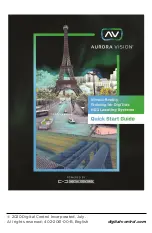
English
28
Remote Control Transmitter
1 POWER ON ( )
●
Turns the power on (Picture is displayed.) when
the <Main power switch> ( / ) is switched to on
( ) and in Standby condition. (see page 29)
2 STANDBY ( )
●
Turns the power off (Standby condition) when the
<Main power switch> ( / ) is switched to on ( )
and the picture is displayed. (see page 29)
3 ASPECT
●
Adjusts the aspect. (see page 33)
4 DEFAULT
●
Resets the settings of picture, sound, etc., to
defaults. (see page 37, 39, 40)
5 ENTER / Cursor buttons ( )
●
Used to operate the menu screens. (see page 35)
6 INPUT
●
Switches input to display on the screen. (see page
31)
7 MUTE
●
Sound mute on / off. (see page 32)
8 PICTURE
(see page 40)
9 SOUND
(see page 39)
10 POSITION
(see page 37)
11 Numeric buttons (0 - 9)
●
Used to input ID number when using several
Displays. (see page 91)
●
Used as shortcut buttons by assigning frequently
used operations. (see page 62)
12 FUNCTION GROUP
(see page 62)
13 ID MODE
(see page 91)
14 Signal emission
15 Remote control operation Indicator
●
Flashes when remote control buttons are pressed.
16 AUTO SETUP
●
Automatically adjusts the position/size of the
screen. (see page 37)
17 MULTI DISPLAY
●
Switches [On] / [Off] in [Multi display setting]. (see
page 51)
18 RETURN
●
Used to return to the previous menu. (see page 35)
19 RECALL
●
Displays the current setting status of Input mode,
Aspect mode, etc. (see page 31)
20 VOL + / VOL -
●
Adjusts sound volume level. (see page 32)
21 SETUP
(see page 46)
22 OFF TIMER
●
Switches to stand-by after a fixed period. (see
page 32)
23 ECO
●
Switches the settings of [Power management
mode]. (see page 55)
24 ID SET
●
Used to set remote control ID number when using
several Displays. (see page 91)
Note
●
In this manual, buttons of the remote control and the
unit are indicated as < >.
(Example: <INPUT>.)
The operation is mainly explained indicating the
remote control buttons but you can also operate with
the buttons on the unit when there are the same
buttons.
















































